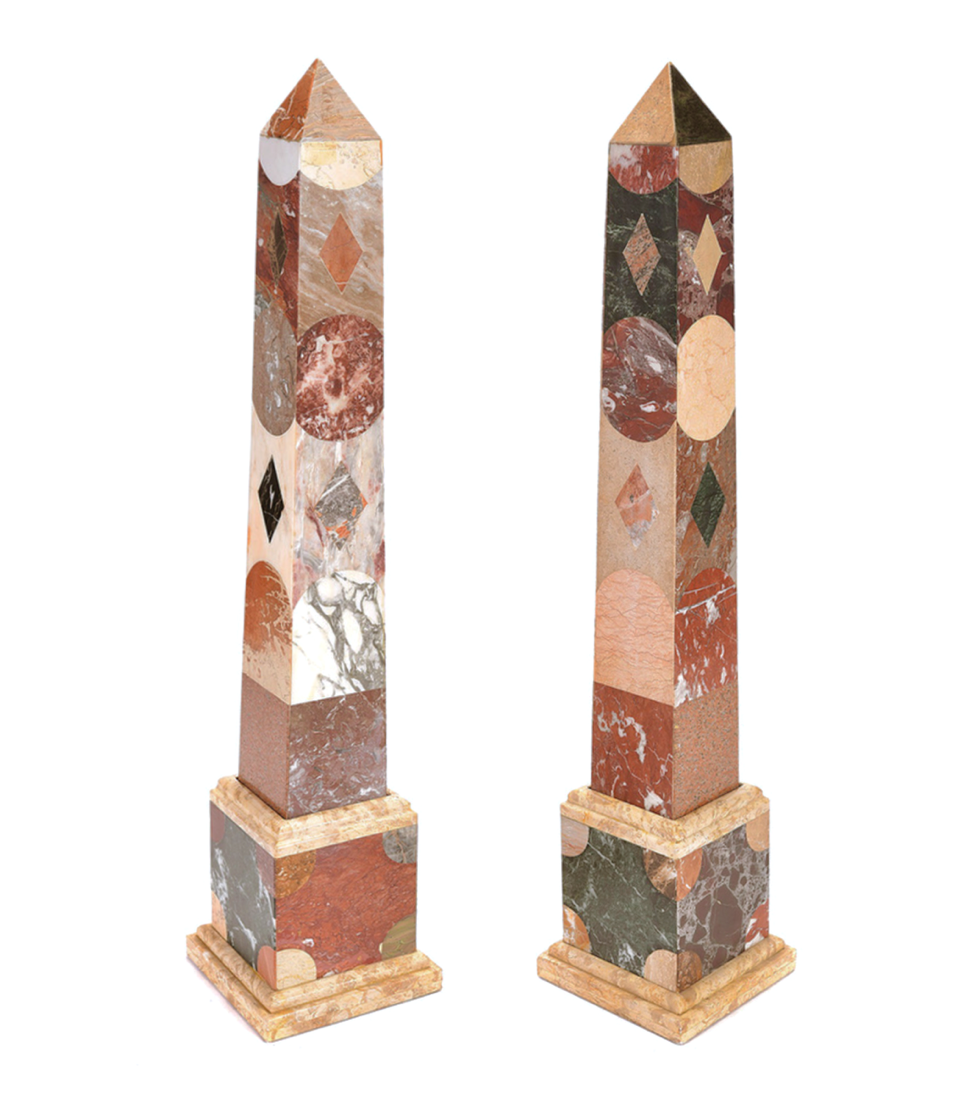

Title: Italian Antique Inlaid Pietra Dura Colored Marble Obelisks
Shipping: $29.00
Artist: N/A
Period: 20th Century
History: Art
Origin: Southern Europe > Italy
Condition: N/A
Item Date: N/A
Item ID: 55
A Pair of Incredibly Large Italian Antique Pietra Dura Inlaid Marble Obelisks. These marble obelisks are massive. Early 20th Century Antique Grand Tour Marble Specimen Obelisks. Italian Marble Set Of Two Obelisks Multi Colored Stones Geometrically Inlaid Works. Very rare to find these this big. To bring these over from Europe would cost you a fortune. These rare obelisks would make an incredible statement by a door or by a fireplace! 4 foot 5" inches tall. {Approximate dimensions: 53 tall x 11 inches wide at base.} Condition: Miniscule signs of wear. The English term "Florentine mosaic" is sometimes also encountered when describing these incredible sculptures. Italian Florentine art has been distributed across the world by tourists and collectors. And it has been difficult To inquire quality examples. Typically ornate with highly decorative art and décor, pieces from Italy tend to have beautiful design elements and fit well into classic spaces. Done with a traditional form and inlaid with a marble pattern, these tall obelisks are fit for a classic space. What's interesting about this kind of work, it is distinct from mosaic in that the component stones are mostly much larger and cut to a shape suiting their place in the image, not all of roughly equal size and shape as in mosaic. In pietra dura, the stones are not cemented together with grout, and works in pietra dura are often portable. As a high expression of lapidary art, it is closely related to the jeweller's art. It can also be seen as a branch of sculpture as three-dimensionality can be achieved. Pietra dura developed from the ancient Roman opus sectile, which at least in terms of surviving examples, was architectural, used on floors and walls, with both geometric and figurative designs. In the Middle Ages cosmatesque floors and small columns etc. on tombs and altars continued to use inlays of different colours in geometric patterns. The Florentines, who most fully developed the form, however, regarded it as 'painting in stone'. As it developed in Florence, the technique was initially called opere di commessi. The delicate process involves cutting and engraving marble shapes manually. To start with, a predefined pattern e.g., floral design or geometrical design is engraved on the marble slab. Small pieces of marble of different shades are cut delicately to fit in these grooves precisely. These small pieces are then slipped in the grooves. Apart from marble, many other materials can also be used In building one of these great pieces of artwork. Inlay work on delicate precious stone began in the workshops of Florence in Italy around the end of the 16th century. This was known as PIETRA DURA.(Pietra= Stone, Dura= Hard) The Italians had created a classic artistic form and held a monopoly over it. From 1630 onwards pietra dura appeared on moveable, small objects as decorative panels, with bird and flower motifs, suitable for cabinet fronts and table tops. Some of these soon reached the Mughals in the form of presents. Of all the Mughal Emperors, Shah Jahan was the greatest patron of architecture in India. For him no amount of money or time was too much to create enduring, everlasting architectural beauty and through it be remembered always. It is in his buildings that one feels most compelled to make the connection between Mughal art and pietra dura. The Taj Mahal, the cenotaphs of the Emperor and his wife, the main floor and the surrounding marble railings bear very close resemblances to the pietra dura form.
Obelisk. Obelisk, tapered monolithic pillar, originally erected in pairs at the entrances of ancient Egyptian temples. Obelisks were set in pairs, at the entrances of temples, and to some Old Kingdom tombs and closely related to the cult of the Sun God Ra also known as Atum. Obelisks symbolized the stability and the creative force of Atum. Obelisks were believed to act as magical protection to the monuments such as temples and tombs. The Ancient Romans were strongly influenced by the obelisk form, to the extent that there are now more than twice as many obelisks standing in Rome as remain in Egypt. An obelisk was a monument made of stone. Each obelisk was placed in a public place. In ancient Egypt, obelisks were often built in pairs. The pharaohs ordered these huge monuments built for them so that they would always be remembered.
Link: https://en.wikipedia.org/wiki/Pietra_dura
Pietra dura, is a term for the inlay technique of using cut and fitted, highly polished colored stones to create images. It is considered a decorative art. The stonework, after the work is assembled loosely, is glued stone–by–stone to a substrate after having previously been "sliced and cut in different shape sections; and then assembled together so precisely that the contact between each section was practically invisible". Stability was achieved by grooving the undersides of the stones so that they interlocked, rather like a jigsaw puzzle, with everything held tautly in place by an encircling 'frame'. Many different colored stones, particularly marbles, were used, along with semiprecious, and even precious stones. It first appeared in Rome in the 16th century, reaching its full maturity in Florence. Pietra dura items are generally crafted on green, white or black marble base stones. Typically, the resulting panel is completely flat, but some examples where the image is in low relief were made, taking the work more into the area of hardstone carving. Pietre dure is an Italian plural meaning "hard rocks" or hardstones; the singular pietra dura is also encountered in Italian. In Italian, but not in English, the term embraces all gem engraving and hardstone carving, which is the artistic carving of three–dimensional objects in semi–precious stone, normally from a single piece.